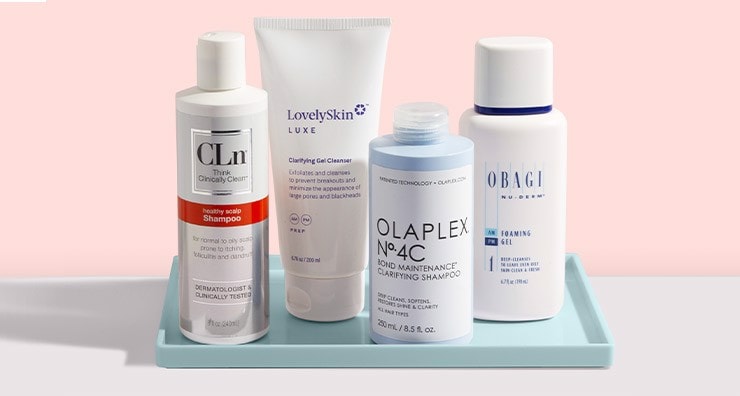
About the Author
Ashley is a content writer at LovelySkin and a self-declared beauty junkie. She enjoys trying out new lip products and spoiling her pets.
Other Posts by AshleyWelcome to LovelySkin.com.

When it comes to sulfates, you may have heard you should avoid them in your beauty regimen, but is there any weight to that claim? Because so many shampoos and cleansers market themselves as sulfate-free, you might be wondering what sulfates actually are and why they’re often used in your favorite products. That’s why we’re going to cover need-to-know topics, including:
Sulfates are found in personal care and cleaning products, such as shampoo, toothpaste and laundry detergent. Derived from petroleum oil or natural sources like coconut, sulfates give your favorite products that sudsy lather we’ve all come to associate with cleanliness.
Many varieties of sulfates exist with some of the most common being sodium lauryl sulfate (SLS) and sodium laureth sulfate (SLES). Sulfates are chemical compounds that lower the surface tension of water, making it easier to grab onto oil and impurities to send them on their way down the drain. The beauty industry has been using them in your favorite products since the 1930s.
The best way to remember what sulfates are used for is to think of them as detergents—or surfactants as we call them in the beauty industry. Most products that have a slippery texture (like shaving cream) or foam up with water (like a foaming face cleanser, shampoo or body wash) contain a sulfate of some sort. However, that’s no reason to panic. Products containing sulfates are much more common than you’d think, and they’re not as harmful as the headlines make them out to be.
The short answer to whether or not sulfates are really bad for your hair and skin is no, not always. The biggest risk associated with sulfates is irritation, which is often experienced by people who are more sensitive or allergy prone. We asked Dr. Joel Schlessinger, LovelySkin’s CEO and board-certified dermatologist, for his opinion on the sulfate controversy.
“I’ve seen sulfates go in and out of popularity over the years. They’ve received a lot of negative press, yet they’re included in many soap-based products because they are very effective cleansers and people love how they suds up nicely,” Dr. Schlesinger says. “Sulfates can sometimes clean a little too well, which is why they’re associated with irritation and dryness. If your skin or scalp are sensitive, common sulfates like SLS and SLES might be too aggressive for you. You can choose to remove sulfates from your regimen or choose products that contain naturally derived surfactants or salt-derived sulfates, which are oftentimes less irritating than petroleum.”
In the hair care industry, stylists often recommend sulfate-free shampoos for color-treated hair because shampoos with sulfates may accelerate color fading, which is the last thing you want after investing time and money at the salon. If your hair is not color-treated, whether to go sulfate-free or not is really up to you. “If your favorite shampoo contains sulfates and you’re not ready to let it go, make sure you follow up with hydrating products to keep potential dryness at bay,” Dr. Schlessinger says.
Now that you know why surfactants are included in many product formulations, it’s up to you to choose whether or not they have a place in your routine. If you’re more sensitive than most, a sulfate-free regimen might be appropriate for you, but it is by no means a requirement. Here are some of our favorite shampoos and facial cleansers formulated with and without sulfates.
This is one of Dr. Schlessinger’s top shampoo recommendations for patients who are struggling with scalp conditions, such as dandruff or folliculitis. Sodium lauryl sulfate foams up to cleanse away dirt and oil, while salicylic acid helps clear away dead skin cells and excess oil on your scalp that can contribute to folliculitis and dandruff. It’s intended for use one to three times a week and can also be used as a beard shampoo for those who are prone to folliculitis or razor burn on the face.
Your favorite facial cleanser may contain sulfates, and that’s not necessarily a bad thing. Obagi’s bestselling Nu-Derm Foaming Gel #1 is a customer favorite that offers an array of benefits. Ideal for normal to oily skin types, this purifying cleanser helps smooth, condition and regulate oil production to help prevent acne. It also contains hydrating aloe leaf juice and glycerin, so your skin won’t feel dry or tight after cleansing. It’s all about the balance of ingredients, and Obagi got it right.
It’s definitely possible to get that super-clean, fresh-from-the-shower feeling without SLS or SLES in your shampoo formula. This clarifying shampoo helps deeply cleanse your scalp by removing excess oil and product buildup along with residue from hard water. It also contains OLAPLEX’s signature bond-building ingredient, bis-aminopropyl diglycol dimaleate, which helps strengthen dry, damaged hair by repairing broken disulfide bonds in each strand of your hair.
For those with sensitive skin, a gentle, sulfate-free cleanser may be the most appropriate option. Formulated by our own Dr. Schlessinger, this gel cleanser easily washes away makeup, dirt and impurities without stripping skin of essential moisture. Featuring patented afaLUXE, a dermatologist-developed molecule that encourages natural exfoliation, along with 2% glycolic and salicylic acids, this exfoliating cleanser keeps breakouts at bay while promoting a more radiant appearance.
Looking for more sulfate-free shampoo options? You can read about six of our favorite sulfate-free shampoos on the LovelySkin Blog.
Follow us on social networks and be one of the first to learn about sales, giveaways, and free samples
| Mon - Fri | 9 - 5 p.m. CT |
|---|---|
| Sat (chat only) | 9 - 3 p.m. CT |
| Sun / Holidays | Closed |
| Call or Text: | 402-697-1100 |
|---|